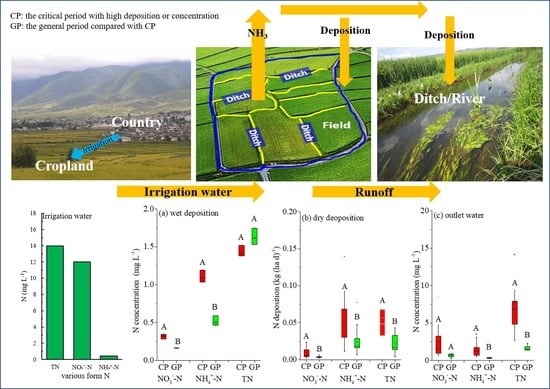Nitrogen Transport/Deposition from Paddy Ecosystem and Potential Pollution Risk Period in Southwest China
Abstract
1. Introduction
2. Materials and Methods
2.1. Site Description
2.2. Measurement of N Deposition
2.3. Measurement of NH3 Volatilization
2.4. Surface Water Monitoring
2.5. Statistical Analyses
3. Results
3.1. NH3 Volatilization
3.2. Wet and Dry Deposition of N
3.3. N Concentrations in Surface Water
3.4. Critical Period of Nitrogen Load via Deposition and Runoff
3.5. Relationship between N Deposition and NH3 Volatilization
4. Discussion
4.1. Relationship between NH3 Volatilization and N Deposition
4.2. Critical Period of Nitrogen Deposition and Runoff
4.3. Suggestions for Agricultural Measures
5. Conclusions
Author Contributions
Funding
Data Availability Statement
Conflicts of Interest
References
- Lin, S.; Shen, S.; Zhou, A.; Lyu, H. Sustainable development and environmental restoration in Lake Erhai, China. J. Clean. Prod. 2020, 258, 120758. [Google Scholar] [CrossRef]
- Chen, Y.Z.; Zhu, J.R. Reducing eutrophication risk of a reservoir by water replacement: A case study of the Qingcaosha reservoir in the Changjiang Estuary. Acta Oceanol. Sin. 2018, 37, 23–29. [Google Scholar] [CrossRef]
- Padedda, B.M.; Sechi, N.; Lai, G.G.; Mariani, M.A.; Pulina, S.; Satta, C.T.; Bazzoni, A.M.; Virdis, T.; Buscarinu, P.; Lugliè, A. A fast-response methodological approach to assessing and managing nutrient loads in eutrophic Mediterranean reservoirs. Ecol. Eng. 2015, 85, 47–55. [Google Scholar] [CrossRef]
- Li, W.C.; Zhai, L.M.; Lei, Q.L.; Wollheim, W.M.; Liu, J.; Liu, H.B.; Hu, W.L.; Ren, T.Z.; Wang, H.Y.; Liu, S. Influences of agricultural land use composition and distribution on nitrogen export from a subtropical watershed in China. Sci. Total Environ. 2018, 642, 21–32. [Google Scholar] [CrossRef]
- Duan, H.T.; Ma, R.H.; Xu, X.F.; Kong, F.X.; Zhang, S.X.; Kong, W.J.; Hao, J.Y.; Shang, L.L. Two-decade reconstruction of algal blooms in China’s Lake Taihu. Environ. Sci. Technol. 2009, 43, 3522–3528. [Google Scholar] [CrossRef]
- Nyenje, P.M.; Foppen, J.W.; Uhlenbrook, S.; Kulabako, R.; Muwanga, A. Eutrophication and nutrient release in urban areas of sub-saharan Africa—A review. Sci. Total Environ. 2010, 408, 447–455. [Google Scholar] [CrossRef]
- Le, C.; Zha, Y.; Li, Y.; Sun, D.; Lu, H.; Yin, B. Eutrophication of lake waters in China: Cost, causes, and control. Environ. Manag. 2010, 45, 662–668. [Google Scholar] [CrossRef]
- Vorosmarty, C.J.; McIntyre, P.B.; Gessner, M.O.; Dudgeon, D.; Prusevich, A.; Green, P.; Glidden, S.; Bunn, S.E.; Sullivan, C.A.; Reidy Liermann, C.; et al. Global threats to human water security and river biodiversity. Nature 2010, 467, 555–561. [Google Scholar] [CrossRef]
- MEP. Bulletin of National Environmental Statistics 2009; Ministry of Environmental Protection: Beijing, China, 2010. [Google Scholar]
- Chien, S.; Prochnow, L.; Cantarella, H. Recent developments of fertilizer production and use to improve nutrient efficiency and minimize environmental impacts. Adv. Agron. 2009, 102, 267–322. [Google Scholar]
- Garnier, M.; Recanatesi, F.; Ripa, M.N.; Leone, A. Agricultural nitrate monitoring in a lake basin in Central Italy: A further step ahead towards an integrated nutrient management aimed at controlling water pollution. Environ. Monit. Assess. 2010, 170, 273–286. [Google Scholar] [CrossRef]
- Yoshikawa, S.; Takahashi, H.; Sasada, Y.; Mochizuki, H. Impact of land use on nitrogen concentration in groundwater and river water. Soil Sci. Plant Nutr. 2015, 61, 898–909. [Google Scholar] [CrossRef][Green Version]
- Tian, Y.H.; Yin, B.; Yang, L.Z.; Yin, S.X.; Zhu, Z.L. Nitrogen runoff and leaching losses during rice-wheat rotations in Taihu Lake Region, China. Pedosphere 2007, 17, 445–456. [Google Scholar] [CrossRef]
- Cui, J.; Zhou, J.; Peng, Y.; He, Y.Q.; Chan, A. Atmospheric inorganic nitrogen in wet deposition to a red soil farmland in Southeast China, 2005–2009. Plant Soil 2012, 359, 387–395. [Google Scholar] [CrossRef]
- Zhao, X.; Zhou, Y.; Min, J.; Wang, S.Q.; Shi, W.M.; Xing, G.X. Nitrogen runoff dominates water nitrogen pollution from rice-wheat rotation in the Taihu Lake region of China. Agric. Ecosyst. Environ. 2012, 156, 1–11. [Google Scholar] [CrossRef]
- Linquist, B.A.; Ruark, M.D.; Mutters, R.; Greer, C.; Hill, J.E. Nutrients and sediments in surface runoff water from direct-seeded rice fields: Implications for nutrient budgets and water quality. J. Environ. Qual. 2014, 43, 1725–1735. [Google Scholar] [CrossRef]
- Buresh, R.J.; Reddy, K.R.; Kessel, C.V. Nitrogen transformations in submerged soils. In Nitrogen in Agricultural Systems; Schepers, J.S., Raun, W.R., Eds.; American Society of Agronomy: Madison, WI, USA, 2008; pp. 401–436. [Google Scholar]
- Gu, B.J.; Ge, Y.; Ren, Y.; Xu, B.; Luo, W.D.; Jiang, H.; Gu, B.H.; Chang, J. Atmospheric reactive nitrogen in China: Sources, recent trends, and damage costs. Environ. Sci. Technol. 2012, 46, 9420–9427. [Google Scholar] [CrossRef]
- Gu, B.J.; Ju, X.T.; Chang, J.; Ge, Y.; Vitousek, P.M. Integrated reactive nitrogen budgets and future trends in China. Proc. Natl. Acad. Sci. USA 2015, 112, 8792–8797. [Google Scholar] [CrossRef]
- Wang, H.Y.; Zhang, D.; Zhang, Y.T.; Zhai, L.M.; Yin, B.; Zhou, F.; Geng, Y.C.; Pan, J.T.; Luo, J.F.; Gu, B.J.; et al. Ammonia emissions from paddy fields are underestimated in China. Environ. Pollut. 2018, 235, 482–488. [Google Scholar] [CrossRef]
- Shen, J.L.; Liu, X.J.; Zhang, Y.; Fangmeier, A.; Goulding, K.; Zhang, F.S. Atmospheric ammonia and particulate ammonium from agricultural sources in the North China Plain. Atmos. Environ. 2011, 45, 5033–5041. [Google Scholar] [CrossRef]
- Wang, J.F.; Zhu, X.; Shen, J.L.; Zeng, G.J.; Wang, J.; Wu, J.S.; Li, Y. Atmospheric ammonia/ammonium-nitrogen concentrations and wet and dry deposition rates in a double rice region in subtropical China. Environ. Sci. 2017, 38, 2264–2272. [Google Scholar]
- Zhang, L.; Vet, R.; O’Brien, J.M.; Mihele, C.; Liang, Z.; Wiebe, A. Dry deposition of individual nitrogen species at eight Canadian rural sites. J. Geophys. Res. 2009, 114, D02301. [Google Scholar] [CrossRef]
- Flechard, C.R.; Nemitz, E.; Smith, R.I.; Fowler, D.; Vermeulen, A.T.; Bleeker, A.; Erisman, J.W.; Simpson, D.; Zhang, L.; Tang, Y.S.; et al. Dry deposition of reactive nitrogen to European ecosystems: A comparison of inferential models across the NitroEurope network. Atmos. Chem. Phys. 2011, 11, 2703–2728. [Google Scholar] [CrossRef]
- Phillips, S.B.; Arya, S.P.; Aneja, V.P. Ammonia flux and dry deposition velocity from near-surface concentration gradient measurements over a grass surface in North Carolina. Atmos. Environ. 2004, 38, 3469–3480. [Google Scholar] [CrossRef]
- Su, C.G.; Yin, B.; Zhu, Z.L.; Shen, Q.R. Ammonia volatilization loss of nitrogen fertilizer from rice field and wet deposition of atmospheric nitrogen in rice growing season. Chin. J. Appl. Ecol. 2003, 14, 1884–1888. [Google Scholar]
- Zhu, J.X.; He, N.P.; Wang, Q.F.; Yuan, G.F.; Ding, W.; Yu, G.R.; Jia, Y.L. The composition, spatial patterns, and influencing factors of atmospheric wet nitrogen deposition in Chinese terrestrial ecosystems. Sci. Total Environ. 2015, 511, 777–785. [Google Scholar] [CrossRef]
- Jia, Y.L.; Yu, G.R.; He, N.P.; Zhan, X.Y.; Fang, H.J.; Sheng, W.P.; Zuo, Y.; Zhang, D.Y.; Wang, Q.F. Spatial and decadal variations in inorganic nitrogen wet deposition in China induced by human activity. Sci. Rep. 2014, 4, 3763. [Google Scholar] [CrossRef]
- Liang, X.Q.; Chen, Y.X.; Nie, Z.Y.; Ye, Y.S.; Liu, J.; Tian, G.M.; Wang, G.H.; Tuong, T.P. Mitigation of nutrient losses via surface runoff from rice cropping systems with alternate wetting and drying irrigation and site-specific nutrient management practices. Environ. Sci. Pollut. Res. 2013, 20, 6980–6991. [Google Scholar] [CrossRef]
- Darzi-Naftchali, A.; Shahnazari, A.; Karandish, F. Nitrogen loss and its health risk in paddy fields under different drainage managements. Paddy Water Environ. 2017, 15, 145–157. [Google Scholar] [CrossRef]
- Xie, Y.X.; Xiong, Z.Q.; Xing, G.X.; Yan, X.Y.; Shi, S.L.; Sun, G.Q.; Zhu, Z.L. Source of nitrogen in wet deposition to a rice agroecosystem at Tai lake region. Atmos. Environ. 2008, 42, 5182–5192. [Google Scholar] [CrossRef]
- Yu, G.Y.; Yang, C.L.; Liu, K.; Yang, H.Y.; Zhang, J.L. Atmosphere deposition of nitrogen and phosphorus in Lake Yangzonghai, Yun Province. J. Lake Sci. 2017, 29, 1134–1142. [Google Scholar]
- Luo, L.C.; Qin, B.Q.; Yang, L.Y.; Song, Y.Z. Total inputs of phosphorus and nitrogen by wet deposition into Lake Taihu, China. Hydrobiologia 2007, 581, 63–70. [Google Scholar] [CrossRef]
- Zhan, X.Y.; Bo, Y.; Zhou, F.; Liu, X.J.; Paerl, H.W.; Shen, J.L.; Wang, R.; Li, F.R.; Tao, S.; Dong, Y.J.; et al. Evidence for the importance of atmospheric nitrogen deposition to eutrophic lake Dianchi, China. Environ. Sci. Technol. 2017, 51, 6699–6708. [Google Scholar] [CrossRef] [PubMed]
- Li, R.Q.; Dong, M.; Zhao, Y.; Zhang, L.L.; Cui, Q.G.; He, W.M. Assessment of water quality and identification of pollution sources of plateau lakes in Yunnan (China). J. Environ. Qual. 2007, 36, 291–297. [Google Scholar] [CrossRef] [PubMed]
- Liu, W.Z.; Li, S.Y.; Bu, H.M.; Zhang, Q.F.; Liu, G.H. Eutrophication in the Yunnan Plateau lakes: The influence of lake morphology, watershed land use, and socioeconomic factors. Environ. Sci. Pollut. Res. 2012, 19, 858–870. [Google Scholar] [CrossRef]
- Wei, L.; Zhong, J.Y.; Yuan, G.X.; Fu, H.; Fan, H.B.; Ni, L.Y.; Xie, P.; Cao, T. Stoichiometric characteristics of four submersed macrophytes in three plateau lakes with contrasting trophic statuses. Ecol. Eng. 2017, 99, 265–270. [Google Scholar]
- Huang, C.C.; Zhang, L.L.; Li, Y.M.; Lin, C.; Huang, T.; Zhang, M.L.; Zhu, A.X.; Yang, H.; Wang, X.L. Carbon and nitrogen burial in a plateau lake during eutrophication and phytoplankton blooms. Sci. Total Environ. 2008, 616–617, 296–304. [Google Scholar] [CrossRef]
- Wang, X.L.; Yang, H.; Gu, Z.J.; Zhang, M.L.; Yang, B.J. A century of change in sediment accumulation and trophic status in Lake Fuxian, a deep plateau lake of Southwestern China. J. Soil Sediment 2018, 18, 1133–1146. [Google Scholar] [CrossRef]
- Tang, Q.X.; Ren, T.Z.; Lei, B.K.; Zhai, L.M.; Hu, W.L.; Zhang, J.Z.; Lin, T.; Liu, H.B. Characteristics of nitrogen and phosphorus loss in various crop rotation systems in northern watershed of Erhai Lake. Plant Nutr. Fert. Sci. 2011, 17, 608–615. [Google Scholar]
- Eghball, B.; Gilley, J.E.; Baltensperger, D.D.; Blumenthal, J.M. Long-term manure and fertilizer application effects on phosphorus and nitrogen in runoff. Trans. ASAE 2002, 45, 687–694. [Google Scholar] [CrossRef]
- Qiu, W.G.; Tang, H.; Wang, C. Rule of loss of nitrogen in the surface water of rice fields and the control technology. J. Agro-Environ. Sci. 2004, 23, 740–744. [Google Scholar]
- Kim, J.S.; Oh, S.Y.; Oh, K.Y. Nutrient runoff from a Korean rice paddy watershed during multiple storm events in the growing season. J. Hydrol. 2006, 327, 128–139. [Google Scholar] [CrossRef]
- Chen, A.Q.; Lei, B.K.; Hu, W.L.; Lu, Y.; Mao, Y.T.; Duan, Z.Y.; Shi, Z.S. Characteristics of ammonia volatilization on rice grown under different nitrogen application rates and its quantitative predictions in Erhai Lake Watershed, China. Nutr. Cycl. Agroecosys. 2015, 101, 139–152. [Google Scholar] [CrossRef]
- Hu, Y.; Peng, J.; Liu, Y.; Tian, L. Integrating ecosystem services trade-offs with paddy land-to-dry land decisions: A scenario approach in Erhai Lake Basin, southwest China. Sci. Total Environ. 2018, 625, 849–860. [Google Scholar] [CrossRef]
- Li, X.; Xiao, Q.F.; Niu, J.Z.; Dymond, S.; van Doorn, N.S.; Yu, X.X.; Xie, B.Y.; Lv, X.Z.; Zhang, K.B.; Li, J. Process-based rainfall interception by small trees in Northern China: The effect of rainfall traits and crown structure characteristics. Agric. For. Meteorol. 2016, 218–219, 65–73. [Google Scholar] [CrossRef]
- SEBA (State Environmental Protection Administration of China). Standard Methods for Water and Wastewater Monitoring and Analysis, 4th ed.; China Environmental Science Press: Beijing, China, 2002; pp. 254–281. [Google Scholar]
- Xue, L.H.; Yu, Y.L.; Yang, L.Z. Maintaining yields and reducing nitrogen loss in rice-wheat rotation system in Taihu Lake region with proper fertilizer management. Environ. Res. Lett. 2014, 9, 115010. [Google Scholar] [CrossRef]
- Huang, P.; Zhang, J.B.; Zhu, A.N.; Xin, X.L.; Zhang, C.Z.; Ma, D.H. Atmospheric deposition as an important nitrogen load to a typical agroecosystem in the Huang-Huai-Hai Plain. 1. Measurement and preliminary results. Atmos. Environ. 2011, 45, 3400–3405. [Google Scholar] [CrossRef]
- Zhang, T.; Liu, H.B.; Luo, J.F.; Wang, H.Y.; Zhai, L.M.; Geng, Y.C.; Zhang, Y.T.; Li, J.G.; Lei, Q.L.; Bashir, M.A.; et al. Long-term manure application increased greenhouse gas emissions but had no effect on ammonia volatilization in a Northern China upland field. Sci. Total Environ. 2018, 633, 230–239. [Google Scholar] [CrossRef]
- Xu, W.; Luo, X.S.; Pan, Y.P.; Zhang, L.; Tang, A.H.; Shen, J.L.; Zhang, Y.; Li, K.H.; Wu, Q.H.; Yang, D.W.; et al. Quantifying atmospheric nitrogen deposition through a nationwide monitoring network across China. Atmos. Chem. Phys. 2015, 15, 12345–12360. [Google Scholar] [CrossRef]
- Erisman, J.W.; Draaijers, G.P.J. Deposition processes and measurement techniques. In Atmospheric Deposition in Relation to Acidification and Eutrophication; Elservier: New York, NY, USA, 1995; Volume 63, pp. 55–77. [Google Scholar]
- Song, Y.Z.; Qin, B.Q.; Yang, L.Y.; Hu, W.P.; Luo, L.C. Primary estimation of atmospheric wet deposition of nitrogen to aquatic ecosystem of Lake Taihu. J. Lake Sci. 2005, 17, 226–230. [Google Scholar]
- Behera, S.N.; Sharma, M.; Aneja, V.P.; Balasubramanian, R. Ammonia in the atmosphere: A review on emission sources, atmospheric chemistry and deposition on terrestrial bodies. Environ. Sci. Pollut. R. 2013, 29, 8092–8131. [Google Scholar] [CrossRef]
- Fenn, M.E.; Bytnerowica, A.; Schilling, S.L.; Vallano, D.M.; Zavaleta, E.S.; Weiss, S.B.; Morozumi, C.; Geiser, L.H.; Hanks, K. On-road emissions of ammonia: An underappreciated source of atmospheric nitrogen deposition. Sci. Total Environ. 2018, 625, 909–919. [Google Scholar] [CrossRef] [PubMed]
- Tang, Y.S.; Braban, C.F.; Dragosits, U.; Dore, A.J.; Simmons, I.; van Dijk, N.; Poskitt, J.; Pereira, G.D.S.; Keenan, P.O.; Conolly, C.; et al. Drivers for spatial, temporal and long-term trends in atmospheric ammonia and ammonium in the UK. Atmos. Chem. Phys. 2018, 18, 705–733. [Google Scholar] [CrossRef]
- Edgerton, E.S.; Saylor, R.D.; Hartsell, B.E.; Jansen, J.J.; Hansen, D.A. Ammonia and ammonium measurements from the southeastern United States. Atmos. Environ. 2007, 41, 3339–3351. [Google Scholar] [CrossRef]
- Horváth, L.; Sutton, M.A. Long-term record of ammonia and ammonium concentrations at K-Puszta, Hungary. Atmos. Environ. 1998, 32, 339–344. [Google Scholar] [CrossRef]
- Walker, J.T.; Whitall, D.R.; Robarge, W.; Paerl, H.W. Ambient ammonia and ammonium aerosol across a region of variable ammonia emission density. Atmos. Environ. 2004, 38, 1235–1246. [Google Scholar] [CrossRef]
- Warner, J.X.; Dickerson, R.R.; Wei, Z.; Strow, L.L.; Wang, Y.; Liang, Q. Increased atmospheric ammonia over the world’s major agricultural areas detected from space. Geophys. Res. Lett. 2017, 44, 2875–2884. [Google Scholar] [CrossRef]
- Shen, J.L.; Li, Y.; Liu, X.J.; Luo, X.S.; Tang, H.; Zhang, Y.Z.; Wu, J.S. Atmospheric dry and wet nitrogen deposition on three contrasting land use types of an agricultural catchment in subtropical central China. Atmos. Environ. 2013, 67, 415–424. [Google Scholar] [CrossRef]
- Zhang, W.F.; Ma, L.; Huang, G.Q.; Wu, L.; Chen, X.P.; Zhang, F.S. The development and contribution of nitrogenous fertilizer in China and challenges faced by the country. Sci. Agric. Sin. 2013, 46, 3161–3171. [Google Scholar]
- Pitcairn, C.E.R.; Leith, I.D.; Sheppard, L.J.; Sutton, M.A.; Fowler, D.; Munro, R.C.; Tang, S.; Wilson, D. The relationship between nitrogen deposition, species composition and foliar nitrogen concentrations in woodland flora in the vicinity of livestock farms. Environ. Pollut. 1998, 2, 41–48. [Google Scholar] [CrossRef]
- Xu, W.; Zheng, K.; Liu, X.J.; Meng, L.M.; Huaitalla, R.M.; Shen, J.L.; Hartung, E.; Gallmann, E.; Roelcke, M.; Zhang, F.S. Atmospheric NH3 dynamics at a typical pig farm in China and their implications. Atmos. Pollut. Res. 2014, 5, 455–463. [Google Scholar] [CrossRef]
- Asman, W.A.H.; Pinksterboer, E.F.; Maas, H.F.M.; Erisman, J.W.; Waijersypelaan, A.; Slanina, J.; Horst, T.W. Gradients of the ammonia concentration in a nature reserve: Model results and measurements. Atmos. Environ. 1989, 23, 2259–2265. [Google Scholar] [CrossRef]
- Ti, C.; Gao, B.; Luo, Y.; Wang, X.; Wang, S.; Yan, X. Isotopic characterization of NHx-N in deposition and major emission sources. Biogeochemistry 2018, 138, 85–102. [Google Scholar] [CrossRef]
- Liu, X.J.; Ju, X.T.; Zhang, Y.; He, C.; Kopsch, J.; Zhang, F.S. Nitrogen deposition in agroecosystems in the Beijing area. Agric. Ecosyst. Environ. 2006, 113, 370–377. [Google Scholar] [CrossRef]
- Xu, A.L.; Wang, P. Phosphorus losses with surface runoff from farm lands in polder area around Taihu basin. J. Agro-Environ. Sci. 2008, 27, 1106–1111. [Google Scholar]
- Yang, S.; Chen, X.; Lu, J.; Hou, X.; Li, W.; Xu, Q. Impacts of agricultural topdressing practices on cyanobacterial bloom phenology in an early eutrophic plateau Lake, China. J. Hydrol. 2021, 594, 125952. [Google Scholar] [CrossRef]
- van Es, H.M.; Sogbedji, J.M.; Schindelbeck, R.R. Effect of manure application timing, crop, and soil type on nitrate leaching. J. Environ. Qual. 2006, 35, 670–679. [Google Scholar] [CrossRef]
- Tang, Q.X.; Ren, T.Z.; Wilko, S.; Liu, H.B.; Lei, B.K.; Lin, T.; Zhang, G.L. Study on environmental risk and economic benefits of rotation systems in farmland of Erhai Lake basin. J. Integr. Agric. 2012, 11, 1038–1047. [Google Scholar] [CrossRef]
- Tan, W.X.; Liu, P.C.; Liu, Y.; Yang, S.; Feng, S.A. A 30-year assessment of Phytoplankton blooms in Erhai Lake using Landsat imagery: 1987–2016. Remote Sens. 2017, 9, 1265. [Google Scholar] [CrossRef]
- Alexander, R.B.; Boyer, E.W.; Smith, R.A.; Schwarz, G.E.; Moore, R.B. The role of headwater streams in downstream water quality. J. Am. Water Resour. Assoc. 2007, 43, 41–59. [Google Scholar] [CrossRef]
- Hua, L.L.; Zhai, L.M.; Liu, J.; Guo, S.F.; Li, W.C.; Zhang, F.L.; Fan, X.P.; Liu, H.B. Characteristics of nitrogen losses from a paddy irrigation-drainage unit system. Agric. Ecosyst. Environ. 2019, 285, 106629. [Google Scholar] [CrossRef]
- Zeng, S.C.; Su, Z.Y.; Chen, B.G.; Wu, Q.T.; Ouyang, Y. Nitrogen and phosphorus runoff losses from orchard soils in South China as affected by fertilization depths and rates. Pedosphere 2008, 18, 45–53. [Google Scholar] [CrossRef]
- She, D.L.; Zhang, L.; Guo, X.M.; Yan, X.Y.; Zhao, X.; Xie, W.M.; Cheng, Y.; Xia, Y.Q. Limited N removal by denitrification in agricultural drainage ditches in the Taihu Lake region of China. J. Soil Sediment 2018, 18, 1110–1119. [Google Scholar] [CrossRef]
- Wang, Z.L.; Li, Y.M.; Zhang, W.L.; Zhang, H.Z.; Zhao, P. Study on nitrogen and phosphorus pollutants changes of main into lake rivers for Kunming Danchi Lake during dry and rainy seasons. J. Yunnan Agric. Univ. 2009, 24, 729–733. [Google Scholar]
- Bergtröm, A.K.; Jansson, M. Atmospheric nitrogen deposition has caused nitrogen enrichment and eutrophication of lakes in the northern hemisphere. Glob. Chang. Biol. 2006, 12, 635–643. [Google Scholar]
- Xu, W.; Zhao, Y.H.; Liu, X.J.; Dore, A.J.; Zhang, L.; Liu, L.; Cheng, M.M. Atmospheric nitrogen deposition in the Yangtze River basin: Spatial pattern and source attribution. Environ. Pollut. 2018, 232, 546–555. [Google Scholar] [CrossRef]
- Cao, J.; Hou, Z.Y.; Li, Z.K.; Chu, Z.S.; Yang, P.P.; Zheng, B.H. Succession of phytoplankton functional groups and their driving factors in a subtropical plateau lake. Sci. Total Environ. 2018, 631–632, 1127–1137. [Google Scholar] [CrossRef]
- Zhang, H.; Song, G.F.; Shao, J.H.; Xiang, X.F.; Li, Q.; Chen, Y.X.; Yang, P.; Yu, G.L. Dynamics and polyphasic characterization of odor-producing cyanobacterium Tychonema bourrellyi from Lake Erhai, China. Environ. Sci. Pollut. R. 2016, 23, 420–5430. [Google Scholar] [CrossRef]
- Feng, Y.W.; Yoshinaga, I.; Shiratani, E.; Hitomi, T.; Hasebe, H. Characteristics and behavior of nutrients in a paddy field area equipped with recycling irrigation system. Agric. Water Manag. 2004, 68, 47–60. [Google Scholar] [CrossRef]
- Hama, T.; Nakamura, K.; Kawashima, S.; Kaneki, R.; Mitsuno, T. Effects of cyclic irrigation on water and nitrogen mass balances in a paddy field. Ecol. Eng. 2011, 37, 1563–1566. [Google Scholar] [CrossRef]
- Wang, X.L.; Li, J.S.; Li, S.M.; Zheng, X.T. A study on removing nitrogen from paddy field rainfall runoff by an ecological ditch-zeolite barrier system. Environ. Sci. Pollut. Res. 2017, 24, 27090–27103. [Google Scholar] [CrossRef]
- Ju, X.T.; Gu, B.J. Status-quo, problem and trend of nitrogen fertilization in China. J. Plant Nutr. Fert. 2014, 20, 783–795. [Google Scholar]
- Ju, X.T.; Gu, B.J.; Wu, Y.Y.; Galloway, J.N. Reducing China’s fertilizer use by increasing farm size. Glob. Environ. Chang. 2016, 41, 26–32. [Google Scholar] [CrossRef]
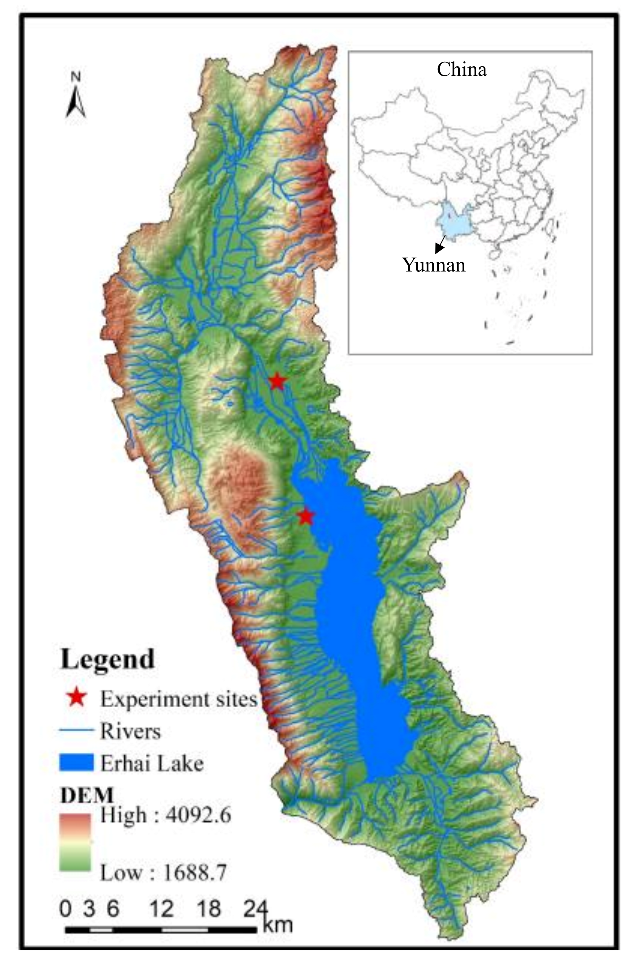
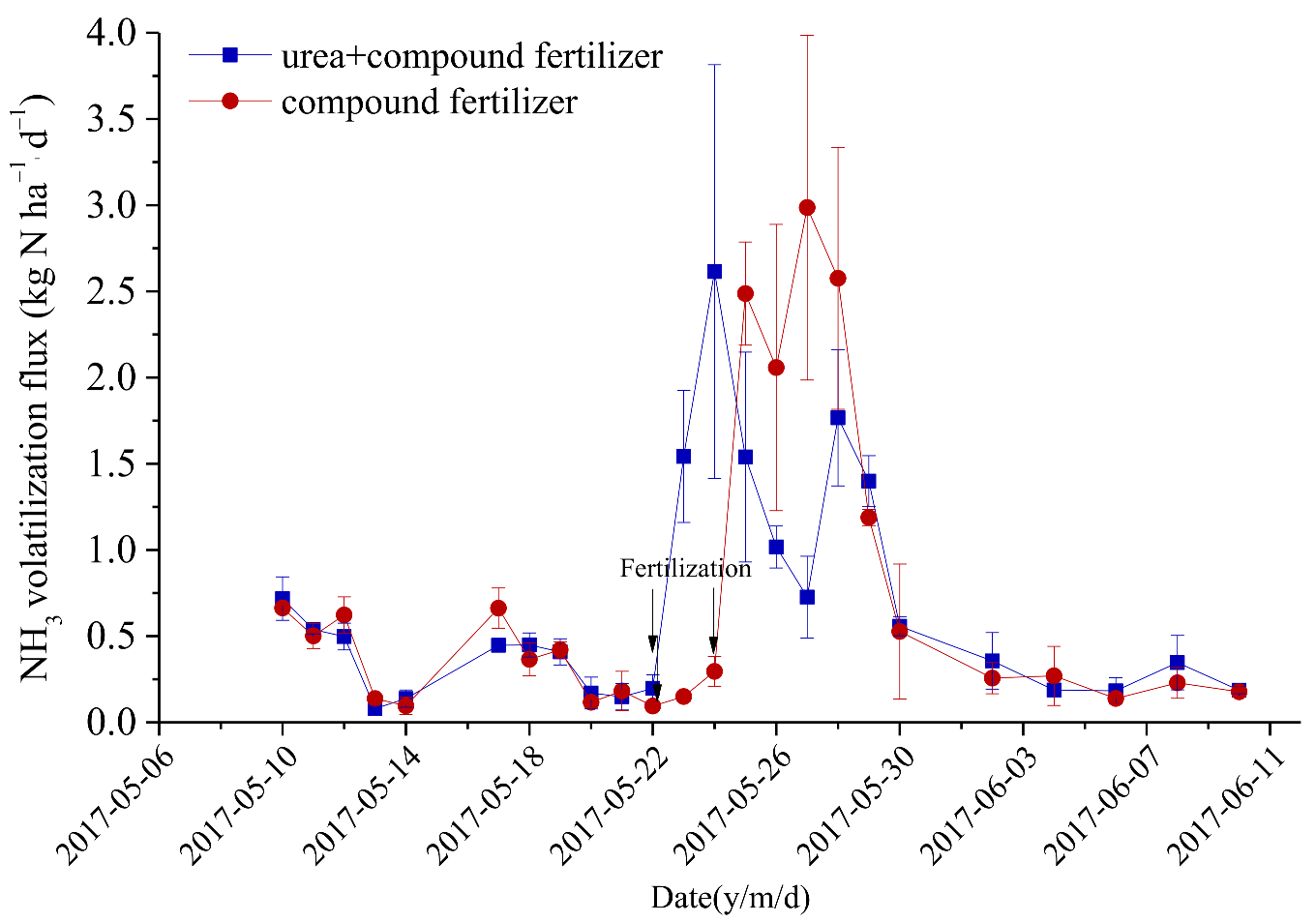
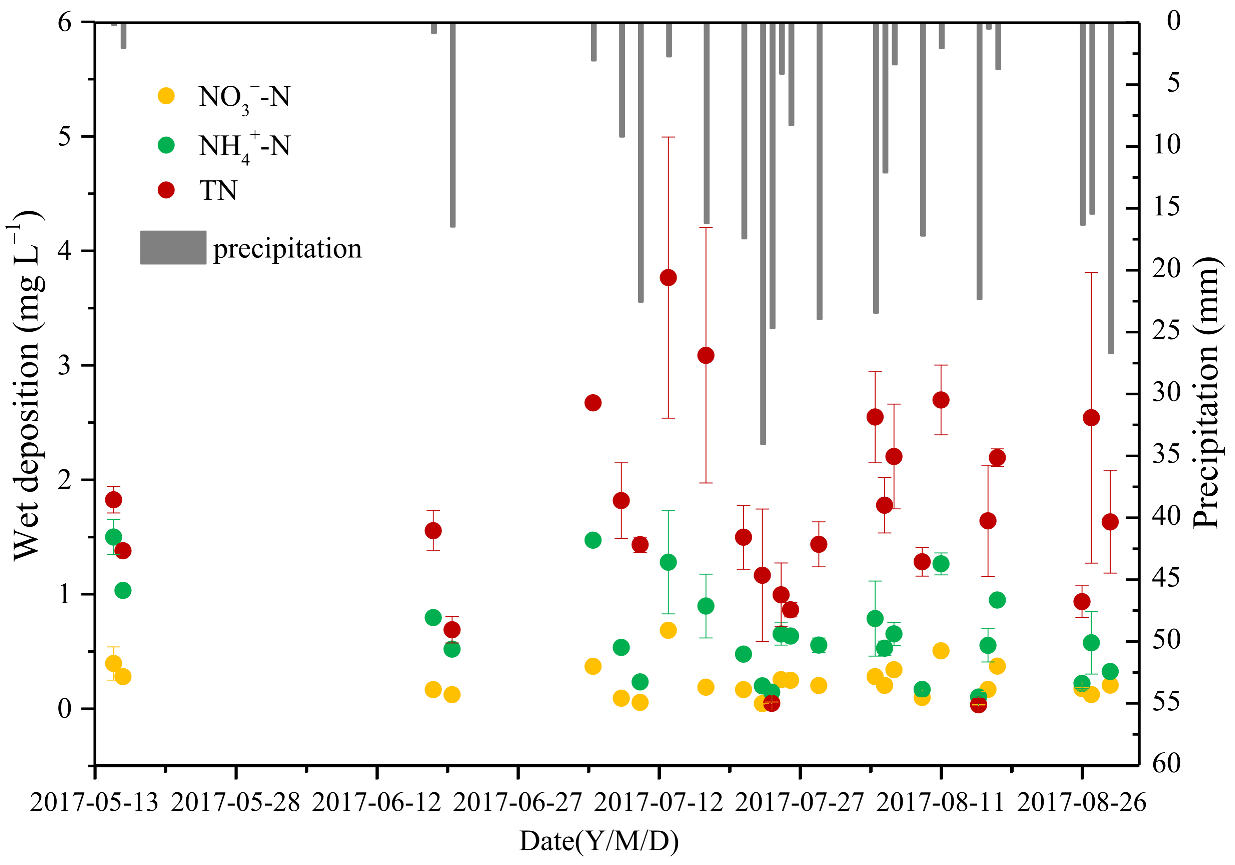

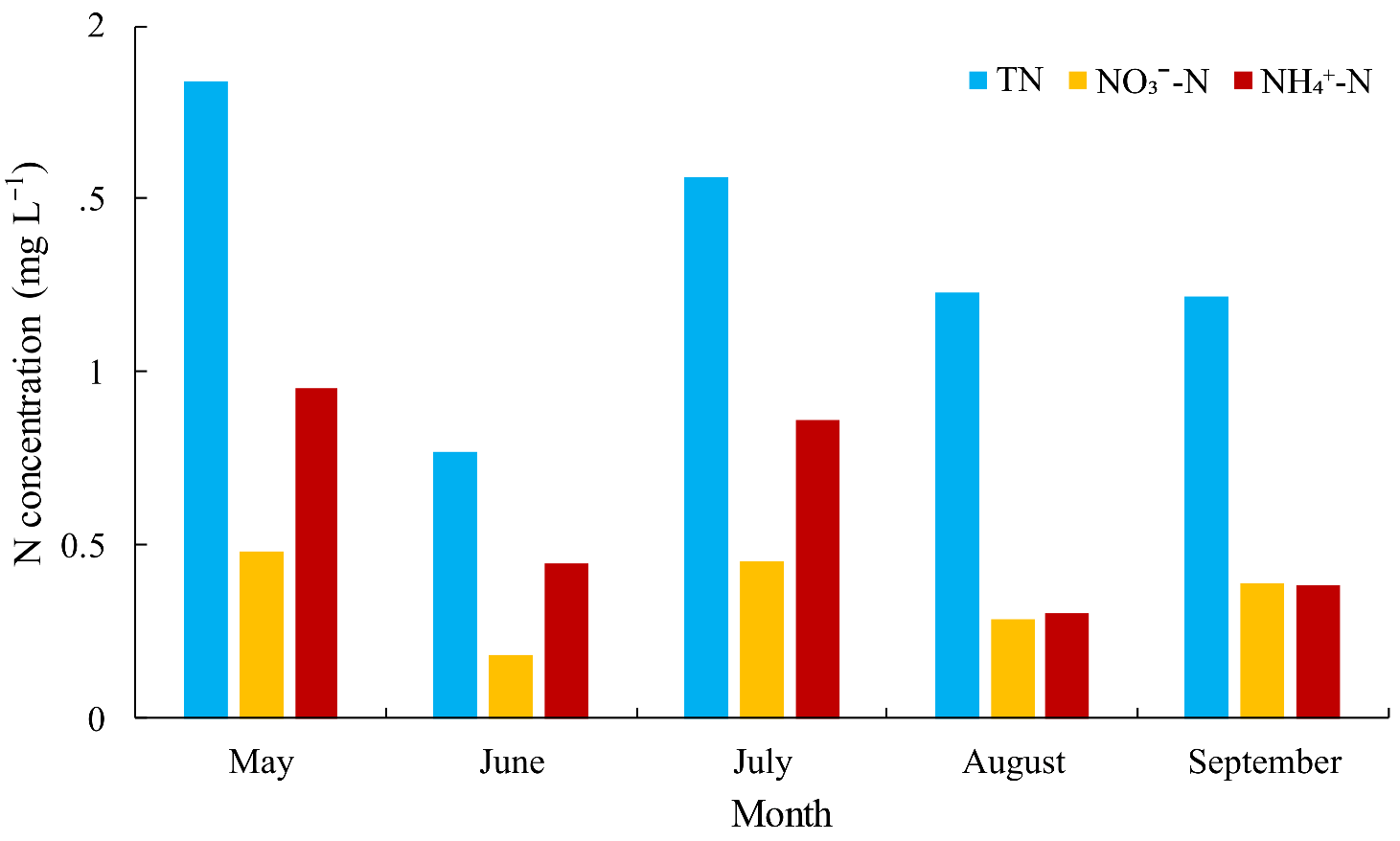
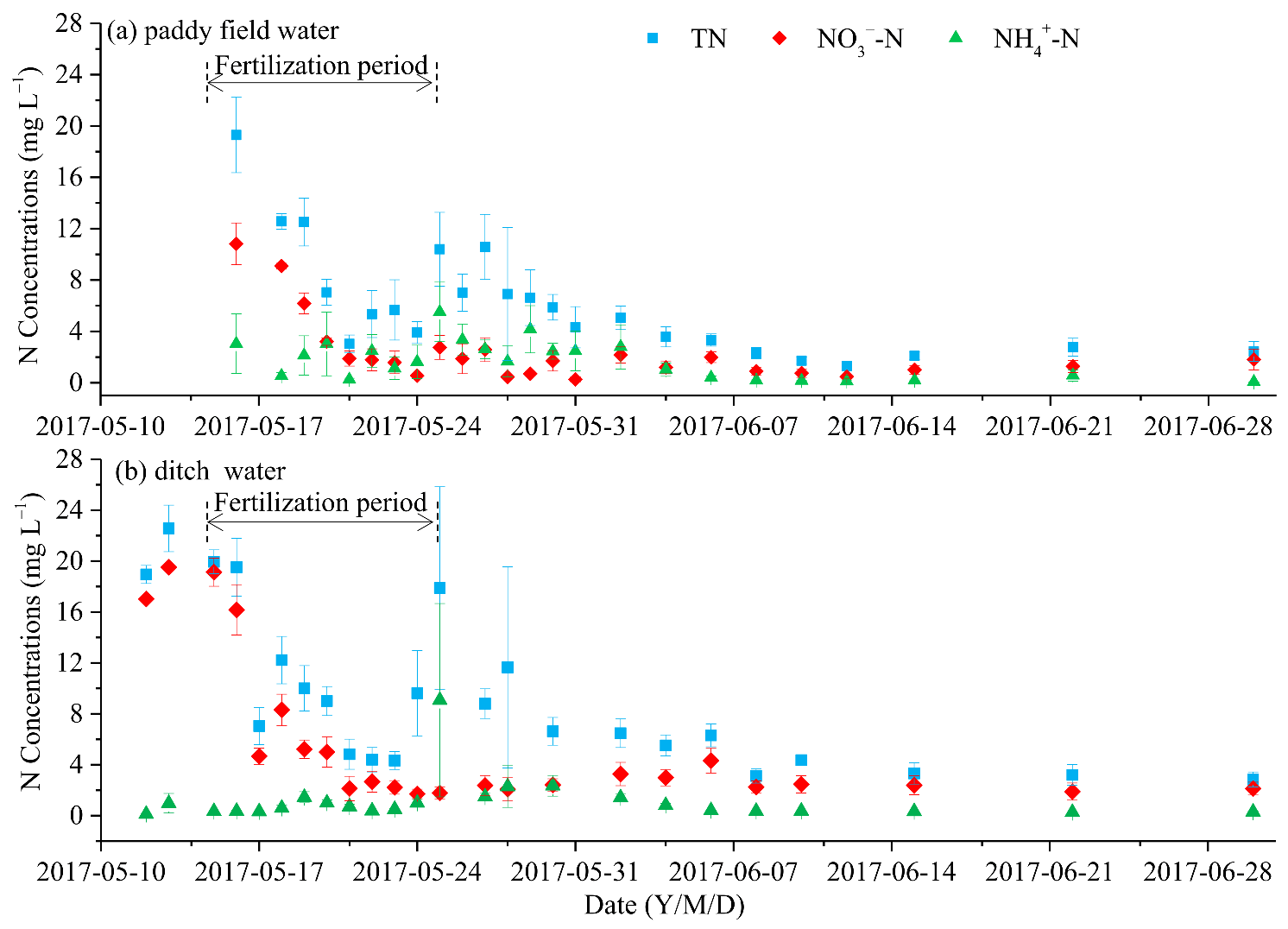
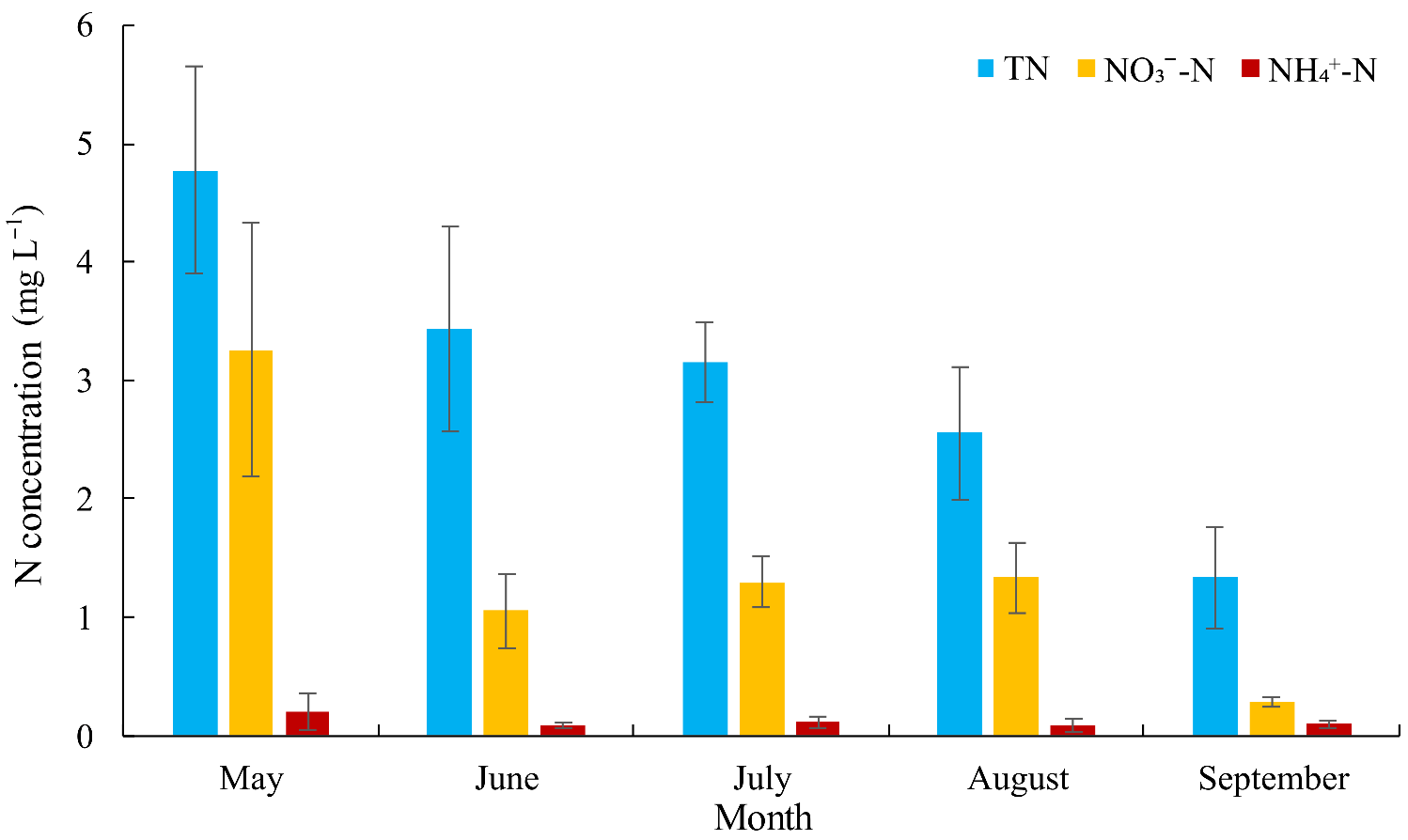
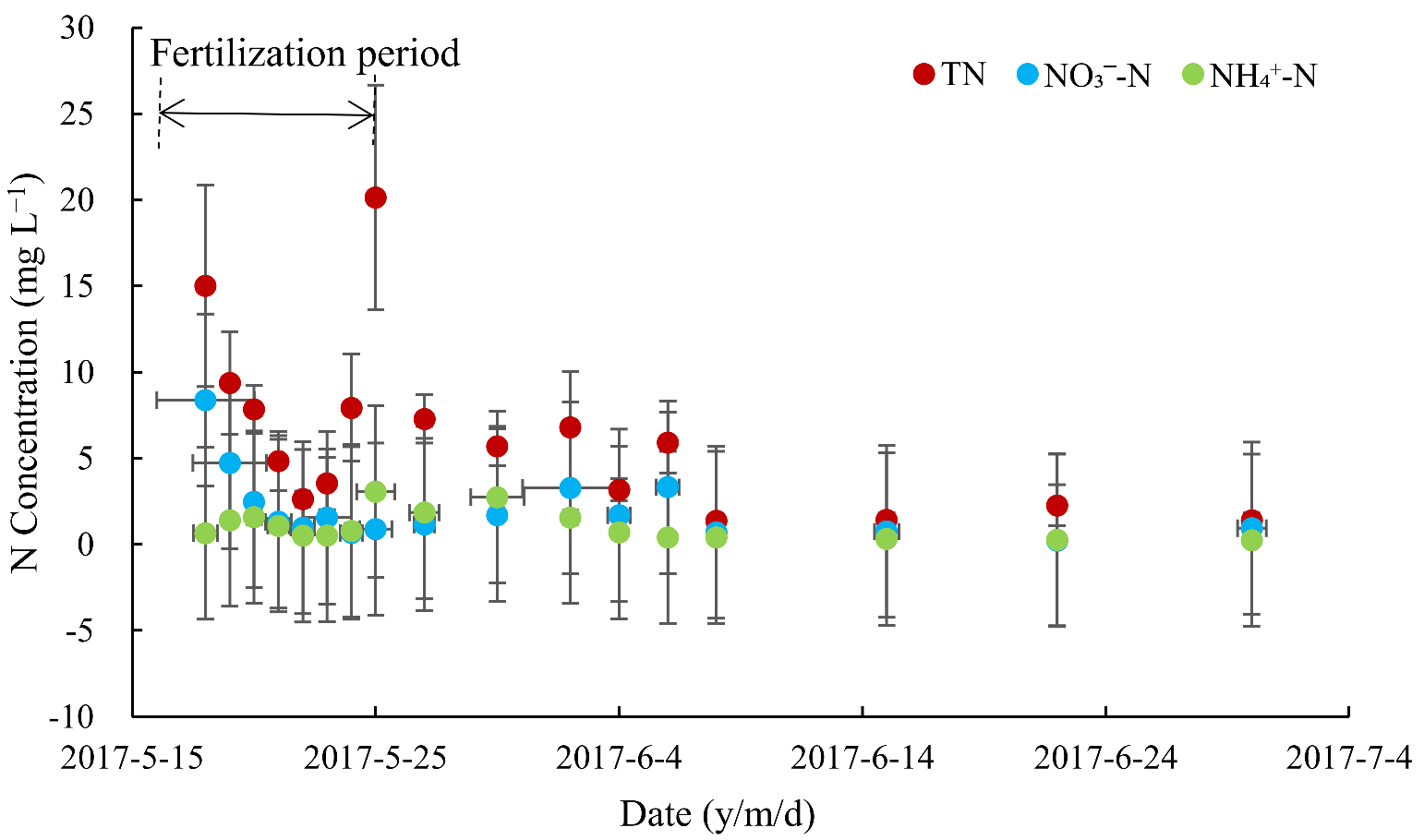
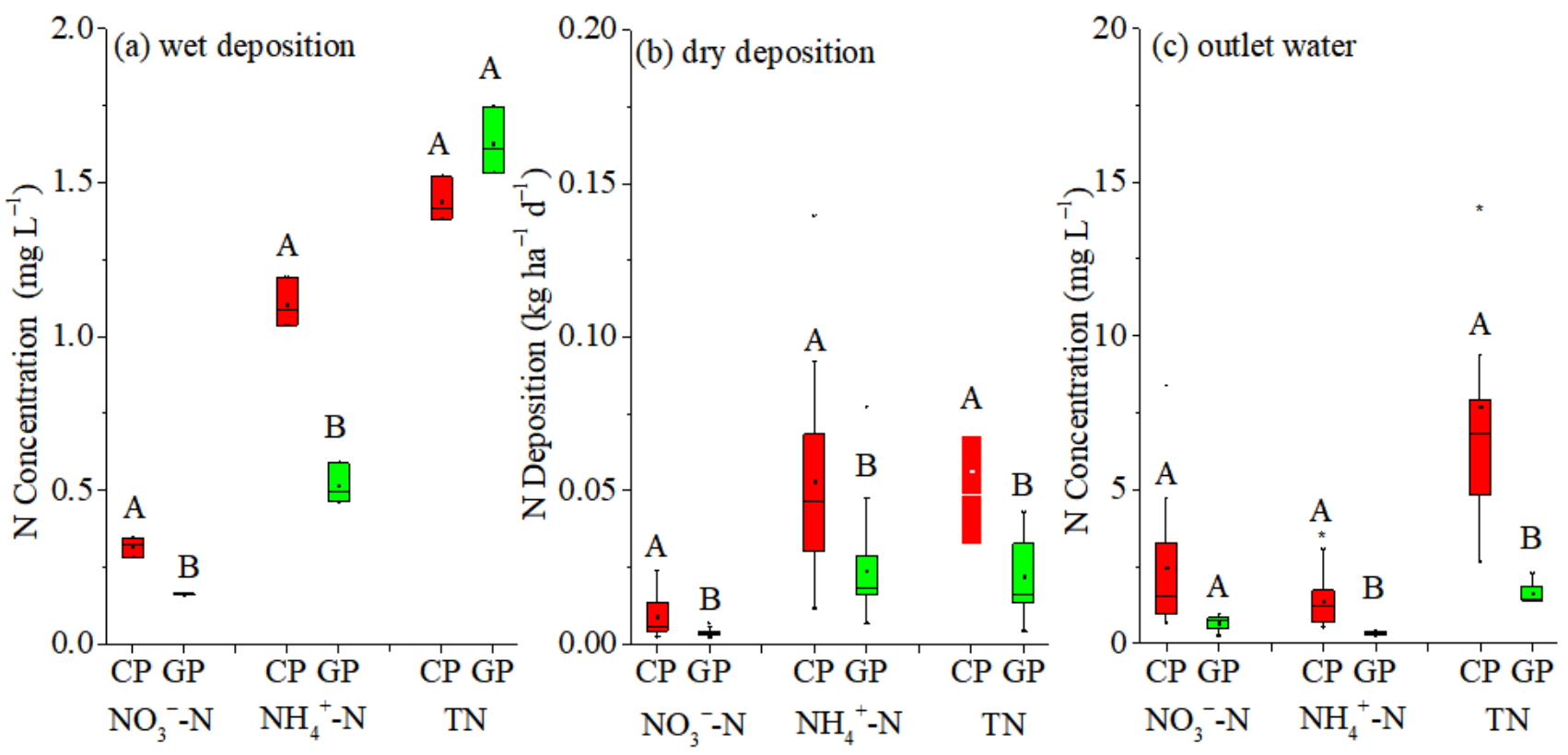
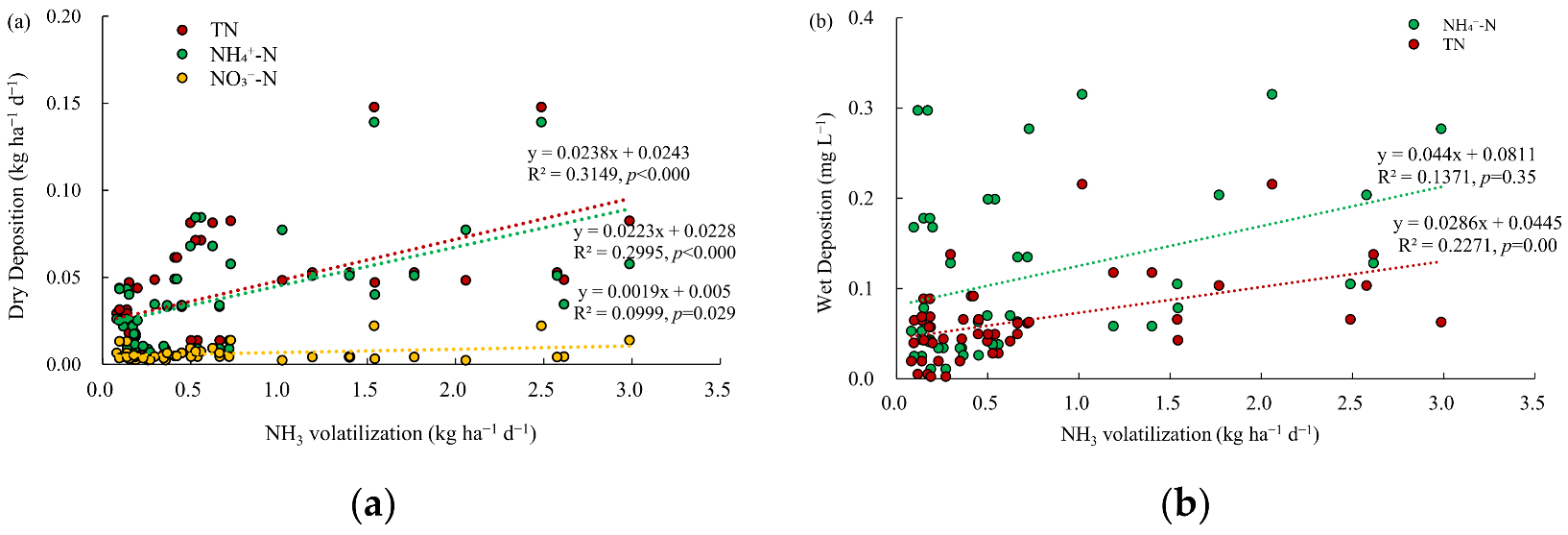
Publisher’s Note: MDPI stays neutral with regard to jurisdictional claims in published maps and institutional affiliations. |
© 2022 by the authors. Licensee MDPI, Basel, Switzerland. This article is an open access article distributed under the terms and conditions of the Creative Commons Attribution (CC BY) license (https://creativecommons.org/licenses/by/4.0/).
Share and Cite
Guo, S.; Yan, T.; Zhai, L.; Yen, H.; Liu, J.; Li, W.; Liu, H. Nitrogen Transport/Deposition from Paddy Ecosystem and Potential Pollution Risk Period in Southwest China. Water 2022, 14, 539. https://doi.org/10.3390/w14040539
Guo S, Yan T, Zhai L, Yen H, Liu J, Li W, Liu H. Nitrogen Transport/Deposition from Paddy Ecosystem and Potential Pollution Risk Period in Southwest China. Water. 2022; 14(4):539. https://doi.org/10.3390/w14040539
Chicago/Turabian StyleGuo, Shufang, Tiezhu Yan, Limei Zhai, Haw Yen, Jian Liu, Wenchao Li, and Hongbin Liu. 2022. "Nitrogen Transport/Deposition from Paddy Ecosystem and Potential Pollution Risk Period in Southwest China" Water 14, no. 4: 539. https://doi.org/10.3390/w14040539
APA StyleGuo, S., Yan, T., Zhai, L., Yen, H., Liu, J., Li, W., & Liu, H. (2022). Nitrogen Transport/Deposition from Paddy Ecosystem and Potential Pollution Risk Period in Southwest China. Water, 14(4), 539. https://doi.org/10.3390/w14040539






